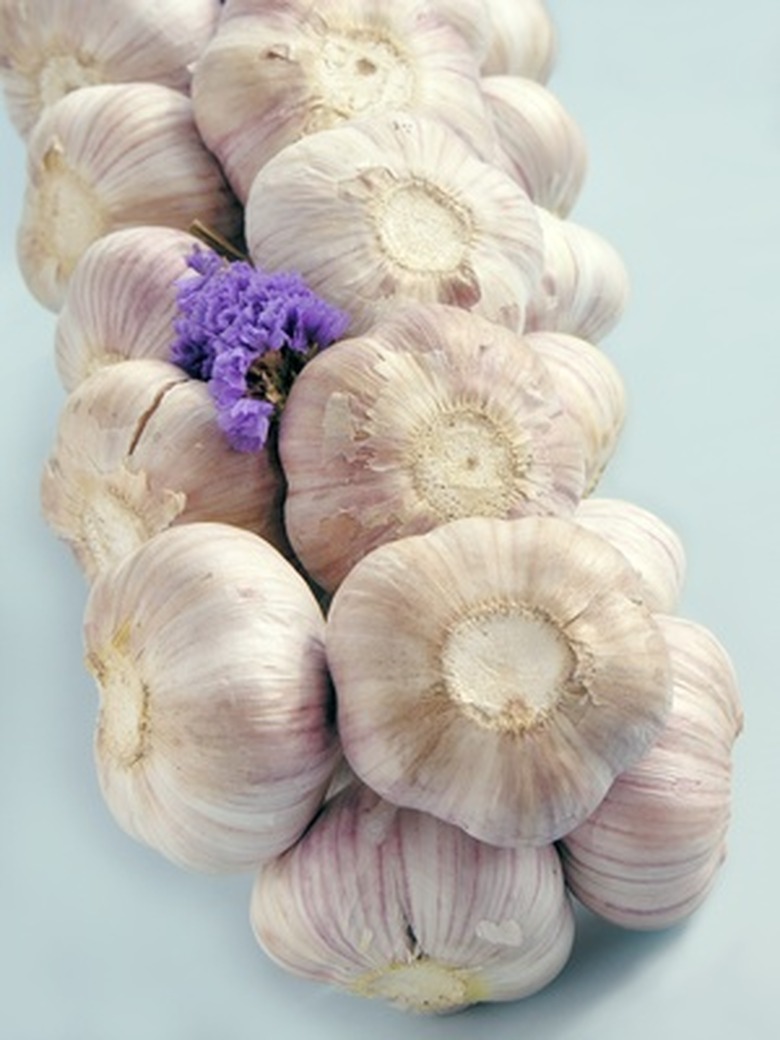Planting & Growing Garlic In Kansas
The aroma of garlic offers enough reason to plant it in Kansas gardens. The state's climate also makes it easy to grow garlic, thanks to the cold winters and warm summers that help the plant mature into ripe bulbs. While garlic grows from cloves bought at the grocery store, consider starting with quality garlic stock bought from a seed supplier. Then once the first plants bear fruit, you can use leftover garlic cloves for planting in the fall.
Description
In early spring, green shoots of garlic appear. The plants resemble onions with long green stems and leaves topped with a flowering crown in the spring. Plants grow up to several feet in height depending on the variety. Similar to onions, the bulbs form underground, producing one bulb per plant. The plants mature between 140 to 160 days after planting.
- The aroma of garlic offers enough reason to plant it in Kansas gardens.
- The state's climate also makes it easy to grow garlic, thanks to the cold winters and warm summers that help the plant mature into ripe bulbs.
Types
Garlic plants consist of two types, soft-neck and hard-neck. Soft-neck garlic plants grow in warmer climates such as in California and along the Oregon coast. Hard-neck garlic grows best in colder winter seasons such as in Kansas. Garlic comes in a wide variety of flavors–from sweet and spicy to bulbs that taste great raw while others require cooking. For Kansas gardens, try Garlic Silver Rose for its mild flavor, or Garlic Musik for its hot and pungent taste. For large bulbs reaching up to 4 inches wide, plant elephant garlic, a mild-tasting variety.
Planting
Fall is the best time to plant garlic in Kansas since the roots get more time to establish themselves. Garlic bulb sets consist of small cloves that form a large bulb. Separate the cloves to prepare for planting. Garlic plants prefer well-drained soil amended with organic matter. Plant the cloves in a sunny location three weeks before the first hard frost. To plant, place each clove in a hole 3 to 4 inches in depth and 5 to 6 inches apart. Cover the area with straw or mulch to protect it from Kansas' cold winter temperatures. In the spring, apply liquid fertilizer, then water regularly, and watch the plants grow.
- Garlic plants consist of two types, soft-neck and hard-neck.
- For large bulbs reaching up to 4 inches wide, plant elephant garlic, a mild-tasting variety.
Harvesting
Watch for browning or yellowish leaves as an indication that garlic is ready for harvesting. Pull up the entire plant, then tie several plants together to form bunches. Some gardeners braid the plant's leaves together for a more appealing look. Then hang the bunches in a cool, dry, and well-ventilated place, and pull bulbs off as needed. Garlic keeps well for up to six months in a cool place.
Uses
Garlic makes a wonderful addition to sauces, stews and soups. Bake a whole bulb in the oven for a spread on toast or crackers. Besides using garlic in cooking, some gardeners plant garlic to keep deer and squirrels out of their gardens and flowerbeds.
- Watch for browning or yellowish leaves as an indication that garlic is ready for harvesting.
- Besides using garlic in cooking, some gardeners plant garlic to keep deer and squirrels out of their gardens and flowerbeds.
